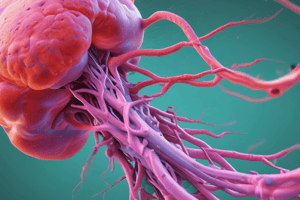Podcast
Questions and Answers
What dose of hydrocortisone per day should prompt a patient to be put on a scheme of gradual withdrawal?
What dose of hydrocortisone per day should prompt a patient to be put on a scheme of gradual withdrawal?
- 10-15 mg/day
- 40-45 mg/day
- 30-35 mg/day
- 20-25 mg/day (correct)
What symptoms are part of the withdrawal syndrome associated with stopping exogenous steroids?
What symptoms are part of the withdrawal syndrome associated with stopping exogenous steroids?
- Cough and shortness of breath
- Headache and dizziness
- Fever and anorexia (correct)
- Rash and itching
What is the potential consequence if a patient on corticosteroid therapy discontinues the steroid during an infection?
What is the potential consequence if a patient on corticosteroid therapy discontinues the steroid during an infection?
- Worsening of the infection (correct)
- No impact on the infection
- Accelerated recovery from infection
- Reduced severity of infection
Why is administration of ACTH during withdrawal not recommended?
Why is administration of ACTH during withdrawal not recommended?
Why might patients on corticosteroid therapy need protection with a corticosteroid if a stressful situation develops up to one year after withdrawal?
Why might patients on corticosteroid therapy need protection with a corticosteroid if a stressful situation develops up to one year after withdrawal?
What is a measure to minimize HPA axis suppression when administering steroids?
What is a measure to minimize HPA axis suppression when administering steroids?
Why are longer acting steroids like dexamethasone not suitable for alternate-day therapy?
Why are longer acting steroids like dexamethasone not suitable for alternate-day therapy?
What is a drawback of alternate-day therapy for some steroid dependent patients?
What is a drawback of alternate-day therapy for some steroid dependent patients?
Why does giving a moderate dose of a short-acting steroid at 48 hour intervals not cause HPA suppression?
Why does giving a moderate dose of a short-acting steroid at 48 hour intervals not cause HPA suppression?
What type of preparations of a steroid with poor systemic availability can be used if appropriate?
What type of preparations of a steroid with poor systemic availability can be used if appropriate?
Flashcards are hidden until you start studying
Study Notes
Corticosteroid Therapy and Withdrawal
- A daily dose of hydrocortisone above 7.5mg should prompt a patient to be put on a scheme of gradual withdrawal to prevent withdrawal syndrome.
Withdrawal Syndrome
- Symptoms of withdrawal syndrome associated with stopping exogenous steroids include:
- Muscle weakness
- Fatigue
- Joint pain
- Arthritis
- Weight loss
- Fever
- Hypotension
- Hypoglycemia
Consequences of Discontinuing Corticosteroid Therapy
- If a patient on corticosteroid therapy discontinues the steroid during an infection, it can lead to a flare-up of the infection, as the body's natural cortisol response is suppressed.
ACTH Administration During Withdrawal
- Administration of ACTH (Adrenocorticotropic Hormone) during withdrawal is not recommended because it can stimulate the adrenal glands to produce more cortisol, making it difficult to assess the patient's natural cortisol response.
Stressful Situations After Withdrawal
- Patients on corticosteroid therapy may need protection with a corticosteroid even up to one year after withdrawal if a stressful situation develops, as their HPA axis may not be fully recovered.
Minimizing HPA Axis Suppression
- One measure to minimize HPA axis suppression when administering steroids is to use alternate-day therapy, which can help preserve the body's natural cortisol response.
Alternate-Day Therapy
- Longer acting steroids like dexamethasone are not suitable for alternate-day therapy because they can suppress the HPA axis even on the "off" day.
- A drawback of alternate-day therapy for some steroid-dependent patients is that it may not provide adequate control of symptoms.
HPA Suppression and Steroid Administration
- Giving a moderate dose of a short-acting steroid at 48-hour intervals does not cause HPA suppression because it allows the body's natural cortisol response to recover between doses.
Steroid Preparations
- Preparations of a steroid with poor systemic availability, such as topical or inhaled steroids, can be used if appropriate to minimize HPA axis suppression.
Studying That Suits You
Use AI to generate personalized quizzes and flashcards to suit your learning preferences.




